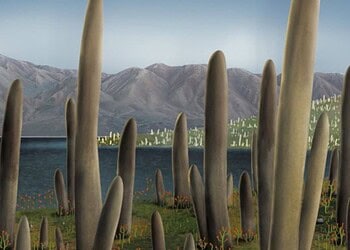
The iconic baobab, known for its distinctive upside-down appearance with trunks and branches resembling roots, has long puzzled scientists regarding its origins and evolutionary history. Recent research has finally shed light on the baobab’s remarkable journey from Madagascar, its place of origin, to mainland Africa and Australia.
The majestic baobab tree: master of survival
Baobabs belong to the genus Adansonia, encompassing nine distinct species. Each species has evolved unique characteristics to thrive in various demanding environments, from the sunbaked savannas of mainland Africa to the arid landscapes of Madagascar and the towering cliffs of Australia. These trees can live for thousands of years, with some specimens estimated to be over 2,000 years old.
The baobab’s physical appearance is as striking as its ecological role. The trunks can reach diameters of up to 30 feet with bark that feels smooth and fibrous. In the dry season, the tree’s leafless branches stretch upwards, resembling roots sticking out of the ground, a feature that has inspired many local myths and legends about upside-down trees. When the rains return, baobabs burst into life, sprouting lush foliage and large, white flowers pollinated by bats and nocturnal insects.
Some baobabs have massive hollow trunks that can hold up to 100,000 liters of water stored in the tree’s cells. In this way, the trees ensure their survival through the harshest droughts while providing sustenance to creatures in their ecosystem. However, their water is sometimes too much of a good thing. The trees are targeted by wildlife, such as elephants in Africa, which gouge the trunks to access water.
Also called the “tree of life,” the baobab is very culturally significant across many regions. These trees have inspired many forms of art, folklore, and traditions. Their fruit, known as monkey bread, is rich in vitamin C and is used in traditional medicine and culinary recipes. The hollow trunks of some older trees serve as makeshift shelters, storage spaces, or even places of worship.
How the baobab conquered the world
The researchers assembled the genomes of all eight recognized baobab species. Through this work, they uncovered patterns of speciation and hybridization. The new study reveals that the baobab lineage originated in Madagascar around 21 million years ago. All eight species appeared on this island where they made hybrids.
The study also revealed that two baobab species managed astonishing long-distance dispersal. One species reached mainland Africa — approximately 250 miles west of Madagascar — and the other found its way to Australia, nearly 7,000 miles east. Their dispersal was likely facilitated by the Indian Ocean gyre. This oceanic current likely helped to transport the seed pods across vast distances sometime in the past 12 million years.
“We were delighted to be involved in this project uncovering patterns of baobab speciation in Madagascar followed by the astonishing long-distance dispersal of two species, one to Africa and another to Australia. This was accompanied by the evolution of some fascinating pollination syndromes involving hawkmoths, lemurs and bats,” said Professor Andrew Leitch at Queen Mary University of London.
Challenges for the baobab
Researchers also found that some Malagasy baobabs have low genetic diversity, which makes them less resilient to environmental changes. This means that climate change “will pose severe threats” to one of the Madagascar-based species, the researchers wrote in their study. They even make a grim projection: this species could be gone by 2080.
All but one of the species is on the IUCN Red List of Threatened Species. Three are considered to be threatened with extinction, one is considered critically endangered, and another is considered endangered, the researchers added.
As such, these new genetic findings suggest that their conservation statuses should be re-evaluated and potentially upgraded to even higher threat levels.
“This work has uncovered new insights into the patterns of speciation in baobabs and shows how climate change has influenced baobab distribution and speciation patterns over millions of years,” said Dr. Ilia Leitch at Royal Botanic Garden Kew.
The findings appeared in the journal Nature.






